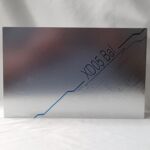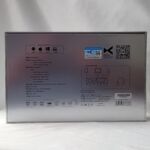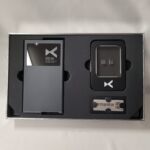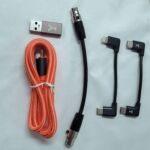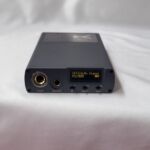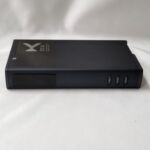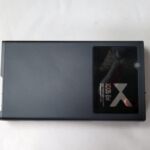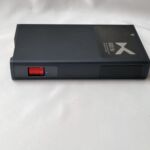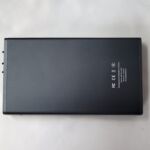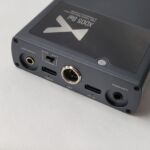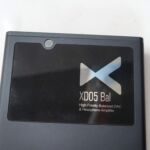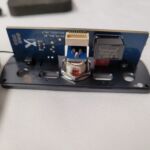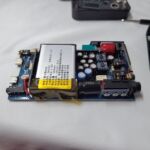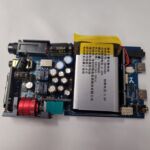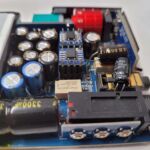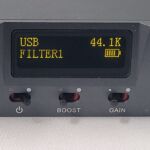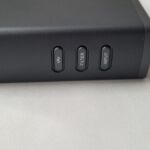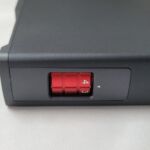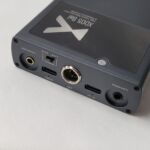Xduoo XD05 Balanced
Disclaimer: The XD-05 balanced was provided by Xtenik for this review at my request and will be given away at THE Show (June9th-12th Long Beach CA). I have owned every model of XD-05 at some point and have put them on my recommended list more than once so do have some expectations going into this review. I do not have a financial interest in Xtenik or in Xduoo. Should you want more information see Xduoo’s website or to purchase an XD-05+, give Xtenik a try.
Unboxing / Accessories:
Xduoo knows how to make a statement with packaging and the XD-05Bal is no exception. The box is metallic silver with blue graphics on the front and specifications on the rear. Its an eye-catching look and my photos don’t do it justice. Lifting the cover of the box reveals the XD-05Bal, an XDuoo key fob, and a pair of additional op-amps in metal tin nestled in a foam surround. The cables, and other accessories are hiding in a box underneath the foam. The kit has two USB interconnects (lightning to C, and C to C), a USB-C cable and USB-A adapter for computer connection or charging, a neoprene pad (Sticker), extra screws, screwdriver, feet, the previously mentioned op-amps, and a 6.3 to 3.5mm jack adapter. The manual and a warranty card round out the package. It is nice to see a kit provide everything one needs out of the box so regardless of what type of phone or computer you intend to pair the XD-05Bal too, you don’t have to go searching for cables.
Build:
Those familiar with the previous generations of XD-05 will recognize the design as it shares a common screen, switches, and most ports with its predecessors. The shell is all aluminum in matte gray and the red highlights of the basic and Plus models are carried over to the volume knob which is now moved to the right hand side. Also in a new location is the power switch which is now the left-most of three switches mounted on the face under the display. Previous generations had the volume knob doing double duty as the on/off switch while the XD-05Bal separates those functions. The face of the unit has a 6.35mm port and a 4.4mm port, on the left and the display on right with power, boost, and gain switches beneath it. On the left side (front) are three more buttons for (front to back) input selection, filter selection, and Blutooth pairing. The left side also holds the Bluetooth antenna and can be seen on the outside as the roughly 2 inch panel at the left rear of the unit. The right side has the large red volume knob and a matching panel that serves only aesthetic purposes and the rear of the unit has two USB type-C ports, two 3.5mm ports (one auxiliary input/output and one coax/optical input), an AES 3 pin input port, and a battery cutoff switch for using the XD-05Bal as a desktop unit. Both USB ports have LEDs beneath them to indicate charging and connection state. One other feature of note is a small microphone on the top face at the rear of the unit. This allows the user to make and receive phone calls while using the XD-05Bal since the headphone ports do not have a microphone pass through feature for use with smartphones.
Internals:
Internally some features like the XU208 are common to the XD-05 family, but many updates have been made even from the most recent Plus model. The XD-05Bal uses dual ESS9038Q2M chips to handle the DAC functions which allows for 32bit/768kHz PCM support and native DSD512 over USB. AES, Coaxial, and Optical inputs are limited to 24/192 PCM and DSD64(DOP) as a function of the Cirrus logic CS8422 controller used. Clocking is handled by a pair of oscillators at 44.1 and 48kHz respectively and an Intel CPLD handles jitter reduction and clock sync. Bluetooth duties are handled by the Qualcomm CSR8675 chip which supports SBC, AAC, AptX, AptX HD, and LDAC. Battery power is provided by a 5000mAh lithium ion cell which provides a roughly 10 hour battery life using USB input at normal listening levels (78dB) or nearly 15 hours using coax, optical, or AES inputs. When using the XD-05Bal purely as an amplifier via the auxillary input, battery life exceeds 24 hours as it bypasses all of the input and dac circuitry. This also means the filters have no effect when using aux input. It takes roughly 5 hours to charge from complete drain so use of the battery cutoff when used as a desktop amplifier allows the user to save the battery for when it is needed.
The Op-amps are seated in Dip-8 sockets to allow for easy swaps with the unit shipping with both OPA1612 and NE5532. I did my listening with the stock op-amp (still OPA1612) and then promptly swapped in a pair of Muses03 to see what impact they had on sound quality. There are plenty of options for op-amp rolling but the case design will limit the height of usable op-amps to slightly more than a standard IC op-amp. I was able to get the Burson V5i in with a little fiddling as both the sockets are close together and they are borderline too tall. The standard Burson series, Staccato, and SparkOS op-amps will not fit due to either width, height, or both.
Controls:
All controls are either on the front of the unit or down the side nearest the headphone jack. On the front are three switches for power, boost, and gain. On/off needs little discussion but Boost is a bit less clear as to its function and flipping it back and forth (while not recommended) doesn’t immediately explain its function either. Boost is listed as an increased thrust switch in the manual which isn’t a particularly useful definition either unfortunately. What the Boost switch actually does is Impedance matching, with the off position for headphones at or below 150Ω and the on position for things exceeding that same value. The Gain switch in the lower position allows the XD-05Bal to be used with more sensitive in-ears and even with the Andromeda hiss was kept to a bare minimum as long as gain and boost were set correctly.
Buttons on the side of the unit allow the user to select input source, filter used, and pair Bluetooth. Input type gives the options for USB, Coax, Optical, AES, and Auxiliary in. On the display, these are shown in the top left corner. Filters are a bit more involved and depend on PCM or DSD input. The filter in use is displayed on the lower left of the display under the source indicator. When using PCM, Filters 1 and 2 are linear phase fast and slow roll-off respectively, Filters 3 and 4 are minimum phase fast and slow, Filter 5 is apodizing fast roll off, Filter 6 is corrected minimum phase fast roll-off and Filter 7 is brick-wall. When using DSD, the manual lists only that the Filter sets the 47k cut-off filter but does not go into extended detail .
Sound:
This is the hardest part of reviewing a DAC/Amp as in a perfect world there would be nothing to talk about. In looking for those places where the XD-05 balanced contributed its own coloration to the signature, the good news is I found none. The presentation was very linear with no noticeable dips or peaks. Slam and rumble are good with no drop-off in intensity during repeated hits or big crescendos as we see with some under-capped amps. Clarity is very good and detail is on par with what we expect from a pair of ESS9038 DACs. With super-sensitive in-ears, there is an audible noise floor between tracks even with the boost set in low and gain on low as well, it isn’t loud, but it isn’t dead silent either. Moving to less sensitive in-ears gives a clean black background and even on low gain things like the Re2000 silver had plenty of power and dynamic range.
On high gain, the XD-05 Balanced is best suited for over-ear headphones and is well matched to the HD-6xx from Sennheiser, the new DT700 Pro X from Beyerdynamic, and even some of the big planars like the M1070 from Monoprice. This is the territory where the XD-05Bal is obviously most at home as even with the higher loads put on it by full sized headphones it has plenty of headroom and can easily push the volume to levels too loud for user safety in all but a few very select cases.
Output Power:
The XD-05 Balanced offers 1 Watt of output power into 32Ω loads via either the 6.35mm or 4.4mm port. Some will point out that there is no difference in output levels and dub this “fake” balanced but this is a misunderstanding in terms and not a fault of the product. Balanced simply means both channels have equal paths to ground (meaning a single ground isn’t shared between channels which lowers cross-talk and some forms of noise). Differential amplifiers have 2 amplifiers per channel in opposite phase and thus double output voltage swing and thus level. All differential amplifiers are balanced, but not all balanced amplifiers are differential. (Calling things out without doing your homework first is a huge pet peeve for me – don’t get me started). I found it had no trouble powering things like the Fostex T50rp or He560 to levels above those safe for average listening. Noise floor is fairly low on low gain, but some sensitive iems will still have some hiss as mentioned earlier. Even the He-6 can be powered to acceptable levels although this is probably taxing the amp more than recommended for long-term use.
Bluetooth:
Earlier XD-05s required an add-on unit to support Bluetooth. It worked well but was cumbersome as it had to be charged separately and blocked the charging ports on the XD-05 when in use. It is good to see the functionality added to the base in this model and it worked exactly as expected.
The unit does not support Bluetooth by itself, but does have an add-on, the 05BL that adds this functionality. I have an 05BL that I had previously used with the original XD-05 so transferred it to the Plus to test out its compatibility. The unit works well but looks a little less at home as the matte silver Plus stands in contrast to the polished black 05BL. My biggest complaint on the Bluetooth unit is the fact that it obstructs the input ports so must be removed in order to charge the unit, and with having a separate battery for the Bluetooth module, it has to be charged independently as well. My take away is while the Bluetooth add-on works well, the XD-05 Plus is really at its best with full sized wired headphones and those looking for a Bluetooth solution can likely find more user friendly solutions for the same spend (even in Xduoo’s product line – see XQ23 or XQ25).
Conclusion:
I’ve liked the XD-05 series of DAC/amps since the original model so it wouldn’t be a big shock if I liked the balanced model too, and I do. But, that has to be qualified. One of the big reasons I liked the XD-05 series is they offered great durability, great features, and a price that was usually about two-thirds of what others charged for similar devices. In some ways, that is still true as the iFi Gryphon that is likely the XD-05Balanced closest competitor is still nearly $200 more expensive. But the market has shifted a lot since the original XD-05 arrived and today dongles have replaced all but a few DAC/Amps in the portable space and the ones that remain are divided into two camps with the iFi Hip-dac and Hidizs DH80(s) models offering balanced output for in-ears that don’t require a full watt output. These smaller models don’t command the price tag, nor do they take up the space something like the XD-05bal does. On the other side, the iFi Gryphon and Diablo, the Chord Mojo 2, the Centrance M8v2, and the XD-05Bal belong in the category of portable dac/amps designed to power full sized and high-impedance headphones. Would I dream of attaching a 600Ω DT990 or a Fostex T50rp to one of the first category of dac/amps or most dongles – absolutely not. Would it work using the XD-05 Balanced, absolutely.
S0 that brings me to the reservation, IF you need the power that the XD-05 balanced can provide and the flexibility of inputs, it still retails for about 2/3rds of what others want for the same feature set and it still offers great durability and flexibility in the process. If you need power but not flexibility, the Poke II (also from Xduoo) offers nearly the output of the XD-05 balanced in a package about half the size and slightly less expensive. If your goal is to power your new iem, chances are a dongle or one of the smaller DAC/amps will be a more cost efficient solution.
The XD-05 Balanced is an example of a great product design that hasn’t caught on as well as it was hoped due to market moves as it was coming through the pipeline. Had the XD-05 Balanced entered the market in 2019 it would have been product of the year material. Today, it still offers great value, but the use-case is a bit more limited so its market has contracted around it a bit.
I’ll be giving away your choice of the Poke II or XD-05 Balanced to one lucky person at THE Show coming up June 10th-12th 2022 in Long Beach CA. Come by the Ecoustics booth and say hello and register for a shot at this and several other items to be given away.
Xduoo XD-05 Balanced
-
Packaging - 8/108/10
-
Accessories - 8/108/10
-
Build Quality - 8/108/10
-
Sound Quality - 8/108/10
-
Battery Life - 9/109/10
-
Connectivity - 7.5/107.5/10
Summary
Pros: Great build, lots of input options, good output power, swap-able op-amps, LDAC and AptX HD support.
Cons: large unit, some hiss with sensitive in ears, No MQA support.


